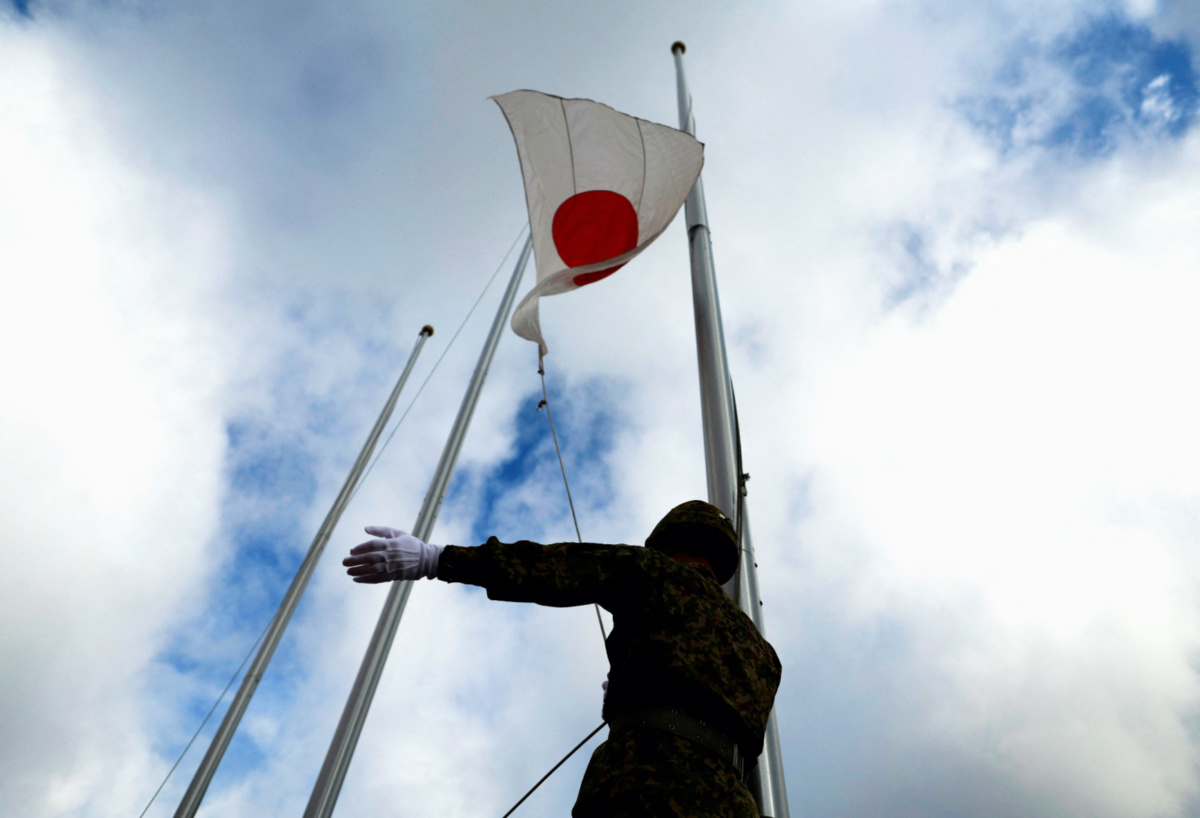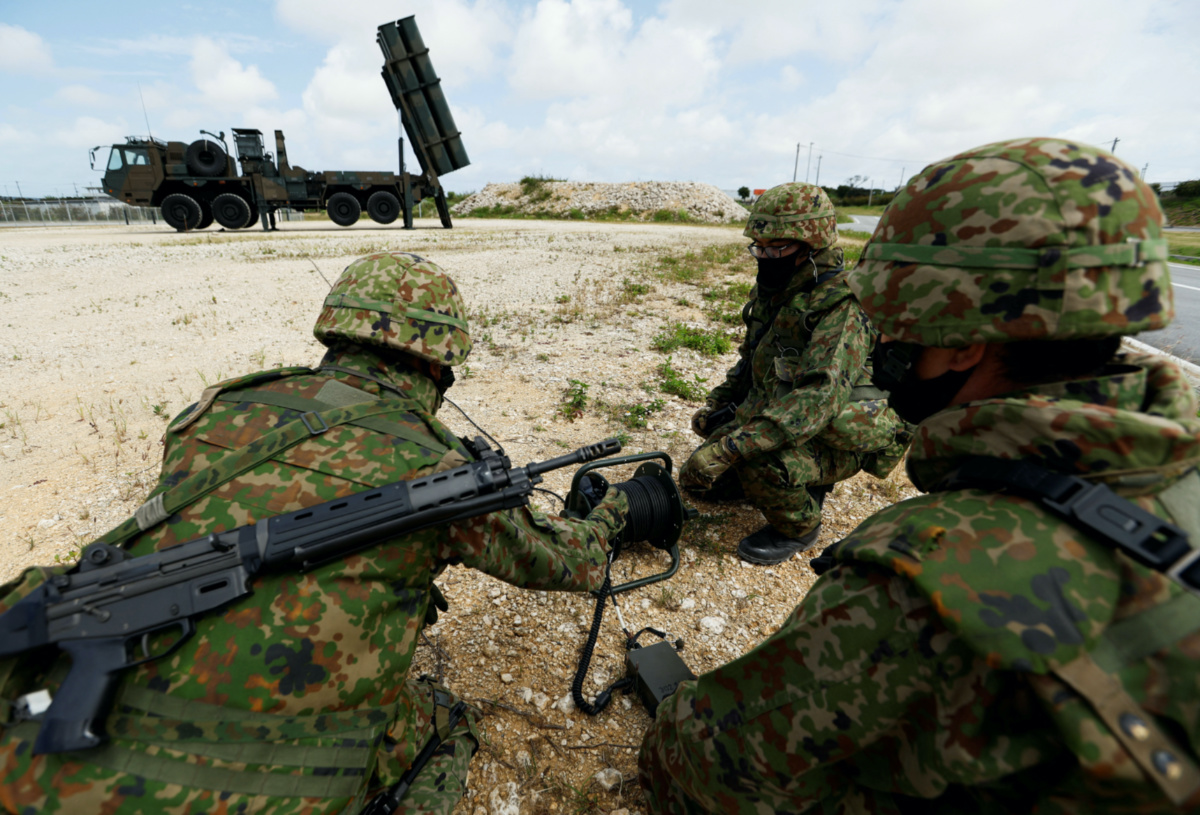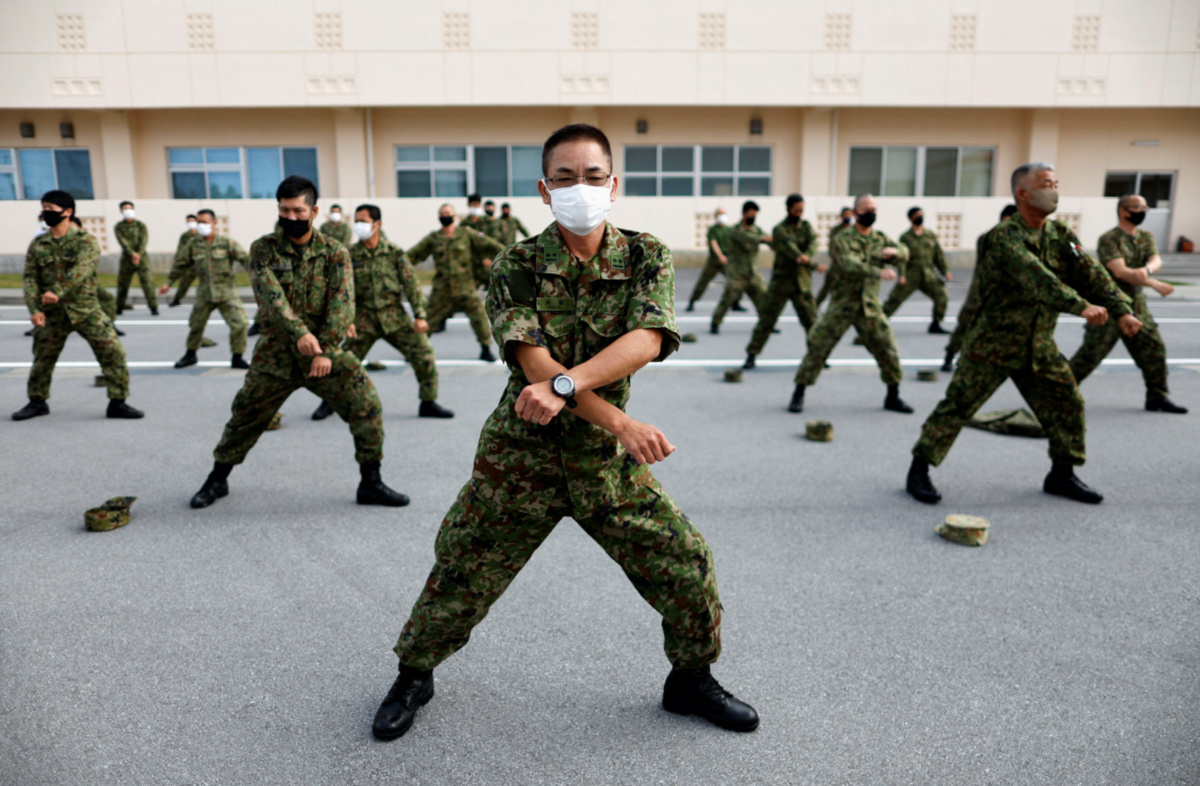Miyako Island, Japan
Reuters
Seihan Nakazato wants the missile trucks on the base next to his melon farm to leave, but few others on Okinawa’s Miyako island, he complains, are demanding that Japan’s army remove such weapons, which he says would make them a target for China.
“We are a small community and there are lots of complicated relationships,” said Nakazato, 68, standing next to one of the greenhouses he worries could be bombed. “Some islanders do work for the base and others have relatives in the military.”

A member of the Japan Ground Self-Defense Force (JGSDF) raises the Japanese national flag in the morning, at JGSDF Miyako camp on Miyako Island, Okinawa prefecture, Japan, on 21st April. PICTURE: Reuters/Issei Kato.
As Nakazato harvests his melons on Japan’s key border outpost, Okinawa on Sunday marks 50 years since the United States ended its occupation, raising hopes of a return to normality after its devastation in World War II. But the East China Sea island chain, which, along with Taiwan, hems in Beijing’s forces, fears it will become a battlefield again.
“We are worried about statements by national lawmakers that a Taiwan contingency would be a Japan contingency, and recent discussions that seem to assume Okinawa would be involved in an armed conflict,” Okinawa’s governor Denny Tamaki said at a news conference on 6th May. The prefecture has about 1.4 million people, most of them on the eponymous main island.
Russia’s invasion of Ukraine has added to those concerns, with Japanese Prime Minister Fumio Kishida warning of the fragility of security in Asia.
And Japanese lawmakers from Kishida’s party have said they want strike missiles added to the country’s arsenal – a weapon that could be deployed to Okinawa.
China, which spends almost five times as much on defence as Japan, says it intentions in the region are peaceful.
“Okinawa will be the front line in the case of a war or conflict between Japan and China,” said Masaaki Gabe, a professor emeritus at the University of Ryukyus on Okinawa’s main island, who described himself as an insecure 17-year-old when the U.S. occupation ended.
“After 50 years, the insecure feeling still continues,” he added.
Strategic value
Fringed with coral reefs and covered in sugar cane, Gabe’s home island is a vital military outpost. It has two airports, a large port and is less than 400 kilometres from Taiwan. It is also 200 kilometres from uninhabited islands in the East China Sea that are the focal point of an intensifying territorial dispute with China.
The Ground Self Defense Force camp next to Nakazato’s farm, which used to be a golf course, is Japan’s newest army base. The missiles deployed there, meant to target Chinese ships sailing in and out the Western Pacific, are the closest such weapons Japan has to China.
“I fear the whole island will become a fortress,” said Hayako Shimizu, 73, the leader of a group of protesters opposed to the base, who stand outside every Thursday with flags planted on Nakazato’s land.
“There aren’t many people who speak up, although I think a lot of people are unhappy with it,” Shimizu added.
Base commander Colonel Masakazu Iyota, 52, thinks most islanders support or accept the presence of the 700 GSDF troops and their equipment, which he described as a “frontline deterrence”.
“I don’t think our current posture is enough,” he said.

Members of the Japan Ground Self-Defense Force conduct a military drill next to an anti-ship missiles unit, at JGSDF Miyako camp on Miyako Island, Okinawa prefecture, Japan, on 21st April. PICTURE: Reuters/Issei Kato.
Next steps
Iyota may get reinforcements after Japan revises its national security strategy this year.
As part of that review, ruling LDP lawmakers have said they want a commitment to more defence spending – including on missiles that can hit targets on foreign soil.
Japan may hold off on deploying such strike weapons to Miyako to avoid provoking China, only 600 kilometres away, but Gabe predicts the country will station aircraft and other missiles in Okinawa.
The next phase of military expansion on Miyako could be at its Shimoji airport, a former senior defence ministry official told Reuters, asking not to be identified because of the sensitivity of the matter.
Built to train jumbo jet pilots, it has been a symbol of resistance to militarisation since Okinawa’s first post-occupation governor, Chobyo Yara, secured a government promise to never deploy military planes there.
Senior ruling Liberal Democratic party lawmakers such as Masahisa Sato have sought to annul that.
“Apart from the main Okinawa island, it is the only other place an F-15 fighter jet can operate from,” said Sato, a former deputy defence minister, who proposed stationing air force jets there in 2020. “As we have seen in Ukraine, you never know when war will break out.”
We rely on our readers to fund Sight's work - become a financial supporter today!
For more information, head to our Subscriber's page.
Island politics
Kishida’s party will need local support in Okinawa to build more bases, a tough proposition when resentment over US forces there dominates politics.
Of 812 Okinawans polled by public broadcaster NHK in March, 56 per cent said they strongly opposed US bases; only a quarter of 1,115 people outside the prefecture said the same.
A test of whether the LDP can gain ground comes in September, when Okinawa chooses its governor. Tamaki, an independent who wants a smaller military footprint, is on the ballot.
On Miyako, Masahiro Hamamoto, 48, who served as an LDP city councilor for eight years, sees a chance for his party to gain support on his island, which depends on farming, tourism and public works spending.
“There is a sense that it benefits the island by having closer political links to central government,” said the local beverage and cigarette wholesaler, who was born two years after Okinawa was returned to Japan.

Members of the Japan Ground Self-Defense Force hold morning preparatory exercises at JGSDF Miyako camp on Miyako Island, Okinawa prefecture, Japan, on 21st April. PICTURE: Reuters/Issei Kato.
The income of Miyako’s 55,000 residents is about 70 per cent of the national average.
“The economy isn’t good, so people will vote for the LDP,” said Toshiaki Shimoji, 61, an Okinawa main island resident who traveled to Miyako to work his family’s farm.
“Russia invaded Ukraine, so there will be more defence spending and that could mean more missiles here. I don’t think base protests will change anything,” he added, sitting on a tractor in a sugar cane field
– Additional reporting by KAORI KANEKO.





